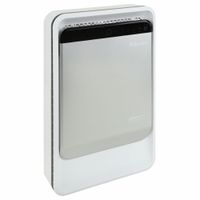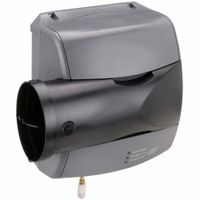Call +(254) 703 030 000 / 751 483 999 / 721 704 777
- Home
- Hvac And Refrigeration
- Air Treatment
.....Read More
Frequently Asked Questions
What is the best air purifier for home use?
Please provide a topic for me to elaborate on.
How do air purifiers work to improve indoor air quality?
Air purifiers work by drawing in air from a room and passing it through a series of filters that capture various airborne pollutants. The most common type of filter is a HEPA (High-Efficiency Particulate Air) filter, which is designed to capture at least 99.97% of airborne particles 0.3 micrometers in size, including dust, pollen, pet dander, mold spores, and some bacteria and viruses. Many air purifiers also include an activated carbon filter, which is effective at absorbing odors, gases, and volatile organic compounds (VOCs) that can be found in household products, paints, and furnishings.
Some air purifiers utilize additional technologies like UV-C light, which can destroy microorganisms such as bacteria and viruses, or ionizers, which release negatively charged ions that attach to airborne particles, making them heavier and causing them to fall out of the air. The cleaned air is then released back into the room, continuously circulating and improving the overall indoor air quality by reducing the concentration of harmful pollutants. Regular filter replacement is crucial for maintaining the efficiency of the air purifier.
What size dehumidifier do I need for my space?
The appropriate size of a dehumidifier depends on several factors, primarily the size of the area you need to dehumidify and the level of humidity in that space. Dehumidifiers are rated by the amount of moisture they can remove in 24 hours, typically measured in pints.
For a slightly damp area (e.g., 50-60% humidity) of about 500 sq ft, a 10-12 pint dehumidifier might suffice. For a moderately damp area (60-70% humidity) of the same size, you would need something closer to a 20-30 pint unit. If the area is very damp (70-80% humidity) or even wet (above 80% humidity, with standing water), you would require a much larger unit, potentially 40-50 pints or more for 500 sq ft, and even larger for bigger spaces.
Consider rooms that are particularly humid, like basements, bathrooms, or laundry rooms. The climate you live in also plays a role; a humid climate will generally require a larger capacity dehumidifier. It's often better to slightly overestimate your needs to ensure efficient and effective moisture removal.
How often should I change the filter in my air purifier?
The frequency of changing your air purifier filter depends on several factors, including the type of filter, the air quality in your home, and how often you use the purifier. * **HEPA filters:** These high-efficiency particulate air filters are designed to capture 99.97% of airborne particles 0.3 microns in size. They typically need to be replaced every 6 to 12 months, or as recommended by the manufacturer.
* **Activated carbon filters:** Often used in conjunction with HEPA filters, these are effective at removing odors, gases, and volatile organic compounds (VOCs). Carbon filters generally require replacement every 3 to 6 months, as their adsorption capacity can become saturated.
* **Pre-filters:** Many air purifiers include a pre-filter to capture larger particles like dust and pet hair, extending the life of the main filters. These are often washable and can be cleaned every 2-4 weeks, depending on usage.Beyond the recommended timelines, pay attention to indicators such as decreased airflow, increased noise from the unit, or a persistent stale odor, all of which suggest the filter is clogged and needs changing. Regular filter maintenance is crucial for the optimal performance of your air purifier and to ensure continued effective air purification in your home.
Can air purifiers help with allergies and asthma?
Yes, air purifiers can be very beneficial for individuals with allergies and asthma. They work by removing airborne particles and contaminants that can trigger symptoms. Common allergens like pollen, pet dander, dust mites, and mold spores can be significantly reduced by an air purifier equipped with a High-Efficiency Particulate Air (HEPA) filter. These filters are designed to capture at least 99.97% of airborne particles 0.3 micrometers in size.
For asthma sufferers, air purifiers can help by reducing exposure to irritants such as smoke, volatile organic compounds (VOCs), and even some bacteria and viruses, depending on the type of filter and technology used (e.g., activated carbon filters for odors and gases). By creating a cleaner indoor environment, air purifiers can help lessen the frequency and severity of allergy attacks and asthma symptoms, leading to improved respiratory health and overall well-being. Regular maintenance, such as replacing filters, is crucial to ensure their continued effectiveness.
What is the difference between a humidifier and a dehumidifier?
A humidifier adds moisture to the air, while a dehumidifier removes it. Humidifiers are useful in dry environments or during winter when heating systems can dry out the air, leading to dry skin, irritated throats, and static electricity. Dehumidifiers, on the other hand, are beneficial in humid climates or damp areas like basements, helping to prevent mold growth, mildew, and musty odors. The choice between the two depends on the specific needs to maintain a comfortable and healthy indoor environment.
How do I maintain my air purifier for optimal performance?
To maintain an air purifier for optimal performance, regular cleaning and timely filter replacement are essential.
First, check and clean the pre-filter, typically a washable mesh, every 2-4 weeks. This filter captures larger particles like dust and pet hair, and keeping it clean prevents it from clogging and reducing airflow. You can usually vacuum it or wash it with mild soap and water, ensuring it's completely dry before reinserting.
Next, monitor the status of the HEPA filter and activated carbon filter. HEPA filters, which capture microscopic particles, generally need replacement every 6-12 months, depending on usage and air quality. Activated carbon filters, used for odors and gases, may need replacement every 3-6 months. Refer to your air purifier's manual for specific replacement schedules, as these can vary by model and manufacturer. Some purifiers have indicator lights to alert you when filters need attention.
Periodically, wipe down the exterior of the unit to remove dust buildup. Also, ensure the air inlets and outlets are not blocked. Proper maintenance ensures the air purifier continues to efficiently remove pollutants from your indoor environment, prolonging its lifespan and maintaining its effectiveness.
Are negative air machines effective in removing pathogens?
Yes, negative air machines, also known as HEPA filtered air scrubbers, are highly effective in removing pathogens from the air. These machines work by creating negative pressure in a designated area, drawing contaminated air into the unit. Inside the machine, the air passes through a series of filters, most importantly a High-Efficiency Particulate Air (HEPA) filter. HEPA filters are designed to capture 99.97% of airborne particles 0.3 micrometers in diameter, which includes many common pathogens like bacteria, viruses, mold spores, and fungi.
By continuously filtering the air and exhausting clean air, negative air machines help to reduce the concentration of airborne pathogens, thereby minimizing the risk of infection and improving indoor air quality. They are commonly used in healthcare settings, laboratories, construction sites, and during remediation projects where airborne contaminants are a concern. Their effectiveness in creating isolation and preventing the spread of airborne infectious diseases makes them a crucial tool in maintaining healthy and safe environments.
How do I choose the right humidifier for my home?
When choosing a humidifier, consider your home's size and the specific needs of its inhabitants. For small rooms, a personal or cool mist humidifier might suffice, while larger spaces could benefit from a console or whole-house model. Ultrasonic humidifiers are quiet and produce a fine mist, whereas evaporative models use a fan to blow air through a moistened wick, offering a more natural humidification process. If you have respiratory issues, a warm mist humidifier can be soothing. Think about features like adjustable humidity levels, automatic shut-off, and ease of cleaning, as these can significantly impact convenience and maintenance. Finally, assess the tank capacity to determine how often you'll need to refill it.
What are the benefits of using a dehumidifier in a basement?
Using a dehumidifier in a basement offers several benefits. Basements are often prone to high humidity due to their subterranean nature, which can lead to various problems. A dehumidifier helps to maintain optimal humidity levels, typically between 30% and 50%, preventing the growth of mold and mildew. Mold thrives in damp environments and can cause musty odors, structural damage to your home, and trigger allergies or respiratory issues. By reducing excess moisture, a dehumidifier also protects wooden structures, furniture, and stored items from warping, rotting, or deterioration. It can also deter pests like dust mites and cockroaches, which prefer humid conditions. Furthermore, by making the air feel less clammy, a dehumidifier can improve overall comfort in your basement, potentially making it a more usable space.



